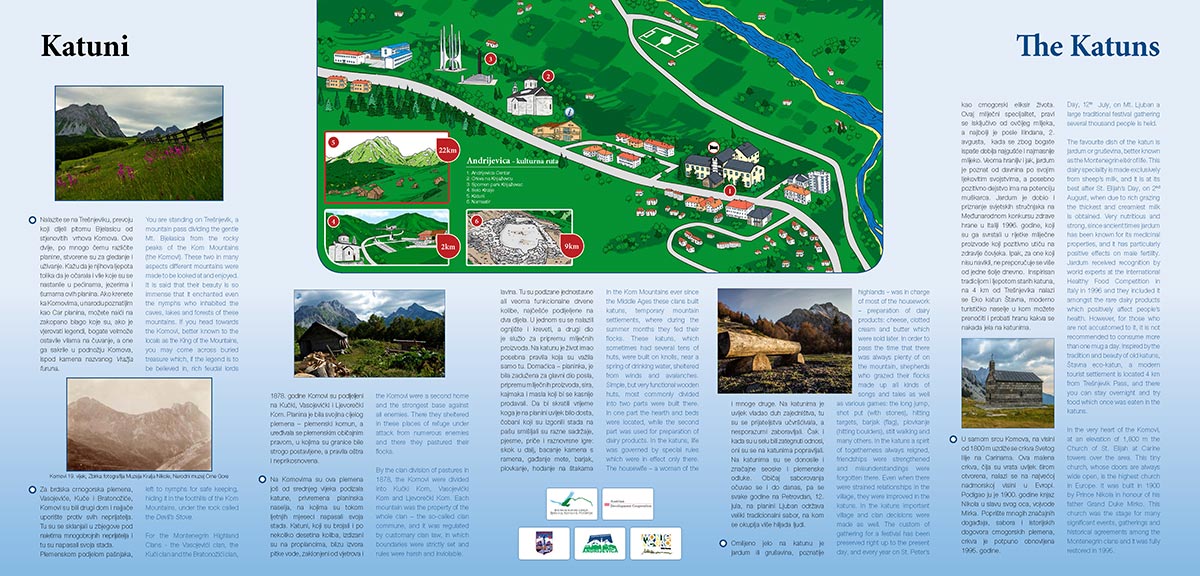You are standing on Trešnjevik, a mountain pass dividing the gentle Mt. Bjelasica from the rocky peaks of the Kom Mountains (the Komovi). These two in many aspects different mountains were made to be looked at and enjoyed. It is said that their beauty is so immense that it enchanted even the nymphs who inhabited the caves, lakes and forests of these mountains. If you head towards the Komovi, better known to the locals as the King of the Mountains, you may come across buried treasure which, if the legend is to be believed in, rich feudal lords left to nymphs for safe keeping, hiding it in the foothills of the Kom Mountains, under the rock called the Devil’s Stove. For the Montenegrin Highland Clans – the Vasojevići clan, the Kuči clan and the Bratonožići clan, the Komovi were a second home and the strongest base against all enemies. There they sheltered in these places of refuge under attack from numerous enemies and there they pastured their flocks.
By the clan division of pastures in 1878, the Komovi were divided into Kučki Kom, Vasojevićki Kom and Ljevorečki Kom. Each mountain was the property of the whole clan – the so-called clan commune, and it was regulated by customary clan law, in which boundaries were strictly set and rules were harsh and inviolable.
In the Kom Mountains ever since the Middle Ages these clans built katuns, temporary mountain settlements, where during the summer months they fed their flocks. These katuns, which sometimes had several tens of huts, were built on knolls, near a spring of drinking water, sheltered from winds and avalanches. Simple, but very functional wooden huts, most commonly divided into two parts were built there. In one part the hearth and beds were located, while the second part was used for preparation of dairy products. In the katuns, life was governed by special rules which were in effect only there. The housewife – a woman of the highlands – was in charge of most of the housework – preparation of dairy products: cheese, clotted cream and butter which were sold later. In order to pass the time that there was always plenty of on the mountain, shepherds who grazed their flocks made up all kinds of songs and tales as well as various games: the long jump, shot put (with stones), hitting targets, barjak (flag), plovkanje (hitting boulders), stilt walking and many others. In the katuns a spirit of togetherness always reigned, friendships were strengthened and misunderstandings were forgotten there. Even when there were strained relationships in the village, they were improved in the katuns. In the katuns important village and clan decisions were made as well. The custom of gathering for a festival has been preserved right up to the present day, and every year on St. Peter’s Day, 12th July, on Mt. Ljuban a large traditional festival gathering several thousand people is held.
The favourite dish of the katun is jardum or gruševina, better known as the Montenegrin elixir of life. This dairy speciality is made exclusively from sheep’s milk, and it is at its best after St. Elijah’s Day, on 2nd August, when due to rich grazing the thickest and creamiest milk is obtained. Very nutritious and strong, since ancient times jardum has been known for its medicinal properties, and it has particularly positive effects on male fertility. Jardum received recognition by world experts at the International Healthy Food Competition in Italy in 1996 and they included it amongst the rare dairy products which positively affect people’s health. However, for those who are not accustomed to it, it is not recommended to consume more than one mug a day. Inspired by the tradition and beauty of old katuns, Štavna eco-katun, a modern tourist settlement is located 4 km from Trešnjevik Pass, and there you can stay overnight and try food which once was eaten in the katuns.
In the very heart of the Komovi, at an elevation of 1,800 m the Church of St. Elijah at Carine towers over the area. This tiny church, whose doors are always wide open, is the highest church in Europe. It was built in 1900 by Prince Nikola in honour of his father Grand Duke Mirko. This church was the stage for many significant events, gatherings and historical agreements among the Montenegrin clans and it was fully restored in 1995.



